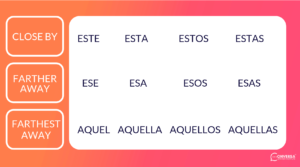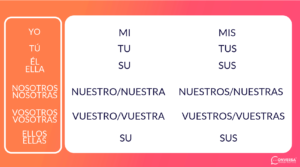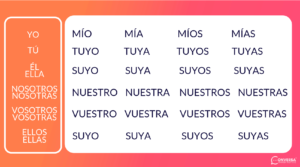- [email protected]
- +34 961258767
- Av. del Marqués de Sotelo 3, Floor 2, Door 4, 46002 Valencia
Accredited Center by Instituto Cervantes
Accredited Center by Instituto Cervantes

Are you learning Spanish and find yourself struggling with grammar? We don’t blame you. Although Spanish doesn’t have a very complex grammar, it’s generally trickier than English grammar. That’s why we want you to forget all your Spanish-related troubles and keep a positive attitude while reading our blogs! Let’s learn Spanish demonstrative and possessive adjectives and enjoy a free online activity below!
Don’t know what they are? That’s okay, you don’t need to become a linguist. Demonstrative adjectives are basically the words you use to express the proximity of the thing we are talking about in relation to the speaker. In English: this, that, these, those. In Spanish, they work the exact same way, except there are three degrees of proximity:

As you can see, in Spanish we will have to pay attention to the gender and number of the noun we are talking about. In other words:
In addition, not only can these adjectives express spacial proximity, but also proximity in time:
Similarly, we have possessive adjectives. Their functionality is the same as the demonstrative but, as the name suggests, instead of expressing proximity they show possession in relation to the speaker.
And so on and so forth.
Now to the tricky part of today’s grammar lesson. The possessive adjectives take two kinds of forms:

Bear in mind that in Spanish, the adjective will change both depending on the speaker AND on the object/person we’re referring to. So let’s check the table below:

In English, when we say “this cat of mine”, we don’t know the gender of the cat. But in Spanish we would be specific, and the possessive adjective will have to match the gender:
As usual, Spanish likes specifying gender and number all the time. It’s not the most practical, but it’s not too hard to learn. In this case, -o for male, -a for female –s for plural. As simple as that. So don’t be intimidated by all the different forms. As we always say, this will naturally fall on your vocabulary with time and practice.
And don’t forget to check out this free online activity below… Click on the lightbulb on the left upper corner to get the English translation of each sentence. It’s a hard one this time!
| Cookie | Duración | Descripción |
|---|---|---|
| cookielawinfo-checkbox-analytics | 11 months | This cookie is set by GDPR Cookie Consent plugin. The cookie is used to store the user consent for the cookies in the category "Analytics". |
| cookielawinfo-checkbox-functional | 11 months | The cookie is set by GDPR cookie consent to record the user consent for the cookies in the category "Functional". |
| cookielawinfo-checkbox-necessary | 11 months | This cookie is set by GDPR Cookie Consent plugin. The cookies is used to store the user consent for the cookies in the category "Necessary". |
| cookielawinfo-checkbox-others | 11 months | This cookie is set by GDPR Cookie Consent plugin. The cookie is used to store the user consent for the cookies in the category "Other. |
| cookielawinfo-checkbox-performance | 11 months | This cookie is set by GDPR Cookie Consent plugin. The cookie is used to store the user consent for the cookies in the category "Performance". |
| viewed_cookie_policy | 11 months | The cookie is set by the GDPR Cookie Consent plugin and is used to store whether or not user has consented to the use of cookies. It does not store any personal data. |
Fill out the form below and our admissions team will get back to you within 24–48 hours.